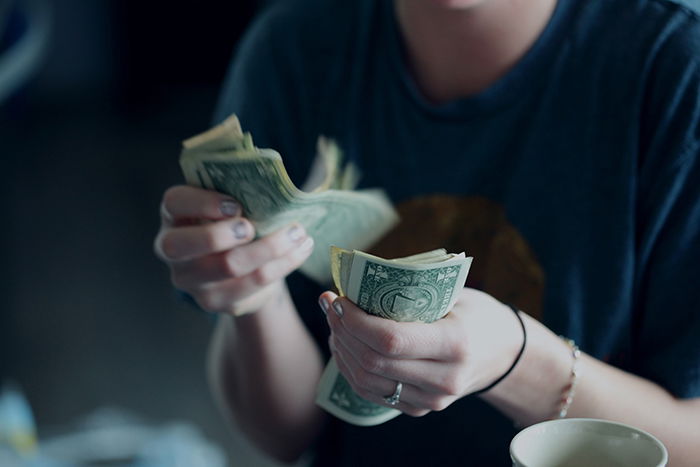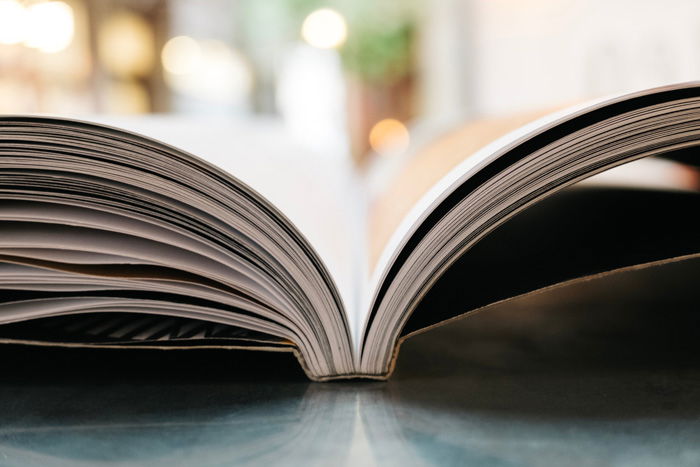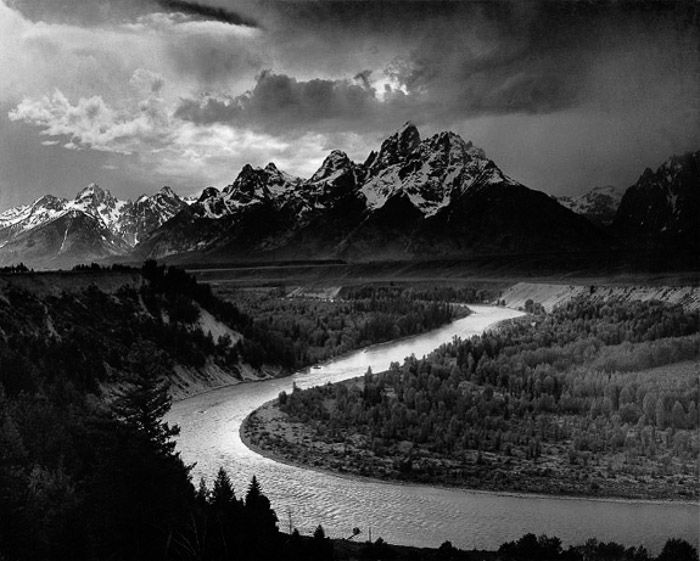Jasper Art Review 2026 (AI Image Generator Pros and Cons)
Are you tired of using the same old stock images and illustrations? Jasper Art is an AI image generator that might be the answer to your problems. It takes basic words and phrases and turns them into amazing images. It’s quick and easy to use. And it creates images in any art style you like.
So are robots taking over the illustration business? This Jasper Art review answers that question. We’re impressed with the AI-generated images. But Jasper Art isn’t without its limitations.
We take you through Jasper Art in detail. We show you how to generate images. And we show you the results. This updated review looks at Jasper’s abilities with photorealistic images. And you’ll know if Jasper Art is the solution for you.
What Is Jasper Art?
Jasper Art is an AI image generator. That means it uses artificial intelligence to generate images. You insert a few keywords and phases. And the Jasper Art bot uses these prompts to create amazing images.
Many readers might be familiar with Jasper AI, the writing assistant. That program uses artificial intelligence to write text. It’s for blogs, websites, and marketing materials. Jasper Art is the artistic sibling of Jasper AI. It’s an AI bot that creates images rather than text.
Jasper Art can take a few words and modifiers to create stunning images. We go into more detail about how to use the program below. But Jasper Art can imitate different artistic styles. And it can copy the style of specific artists.
You can set a mood, and you can select the medium type. You can select acrylic, charcoal, or watercolor. It can even create realistic photo-like images. But as we’ll see, the results are not perfect.
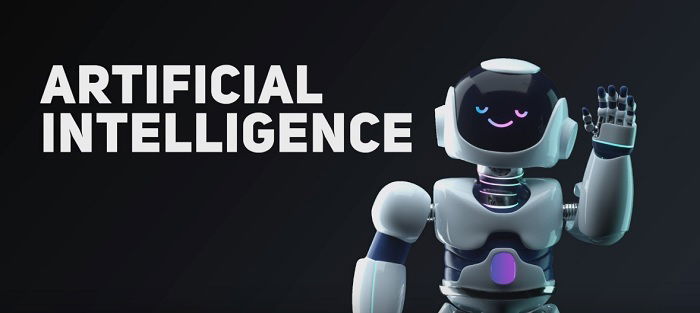
Who Should Use Jasper Art?
Jasper Art is for people who need unique content and need it quickly.
In the world of online commerce, content is king. You need content that attracts attention to sell products or promote brands. And good images are key to beating the competition.
There are excellent websites that provide good-quality stock images. But the online marketplace is so competitive. And other content creators use the same sites to source their images.
This means you lose points for originality by using the same images. And that could affect your SEO score and Google ranking. But you don’t have to rely on the same old stock photos with Jasper AI.
Jasper Art gives you unique images to use for original content. You can generate AI art from any keywords. This means you can create something no one else has.
Plus, you can tailor each generated image to match your content. And because there are so many variables, your competitors will unlikely generate the same thing.
Jasper Art isn’t free. But it’s not expensive if you’re a single user. The paywall might put off casual creators with a slim budget. But for more well-established users, it offers good value for money.
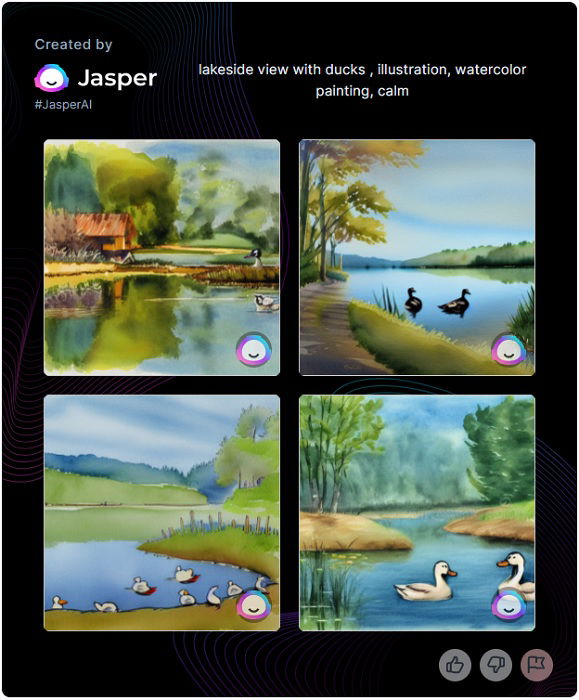
Jasper Art Features
Jasper Art is a single-purpose program. It uses AI to generate images from text prompts. That’s the main feature. But Jasper Art has two modes from which you can generate images:
- Free Form Mode: This lets you type your own words for more specific and unique images.
- Templates: You select specific genres or art styles and generate images within that field using keywords.
We’ll take you through both modes in the following sections.
The Interface
Jasper Art has an easy-to-use interface. It isn’t a big program, so there’s no danger of getting lost. Everything is laid out well, and the tools are easy to find.
As mentioned, there are two modes you can use to generate AI art—Free Form and Templates. All options are in the Free Form mode drop-down menus. And it has a text box for typing prompts.
When you click Create, Jasper gives you four AI images. You can enlarge them individually for a better look and copy or download them.
If you don’t like the results, you can click Create again. And it loads four new images!
You also have options to like or dislike the results. This gives the program feedback. Plus, you can flag images if anything inappropriate is generated.
Jasper Art is quick at generating images. After you click Create, you get four eye-catching images in just a few seconds!
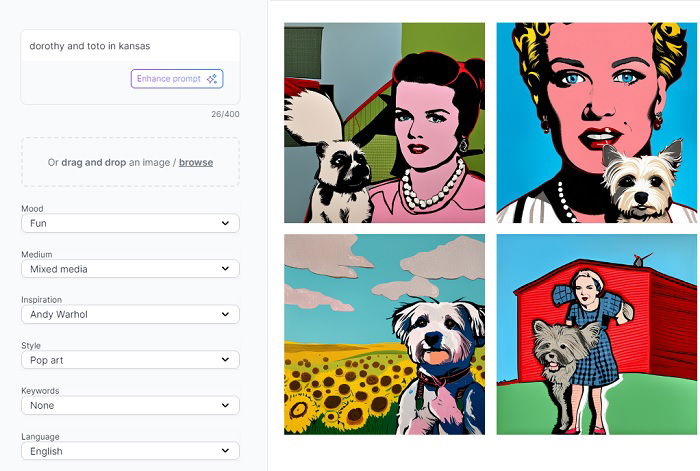
Free Form Mode
Free Form mode gives you the most options when generating images. And it is the easiest way to generate AI art with Jasper.
Jasper Art gives you a 400-character limit in the text box. But it’s more than you need in most cases. And we’ve found it’s best to keep it simple (more on this later).
You start with a basic image description. This can be anything from “apples in a bowl” to “Brad Pitt holding a monkey.” Be specific with your description and type in specific people, animals, or objects.
Using group nouns is also okay. If you type in “fruit,” it gives you a selection of fruit. You don’t need to type “apples, oranges, kiwis,” etc.
You can also use famous characters and celebrities as your subject. As suggested, famous actors are no problem for Jasper Art. Jasper uses AI technology to create images that resemble that person.
Of course, stick to well-known actors and public figures. It won’t know an actor who appeared in a 1989 episode of Murder, She Wrote.
You can see Jasper Art’s rendition of “Brad Pitt holding a monkey” below. It’s in a cartoon style, but the likeness is striking. There’s no denying it looks like Brad Pitt.
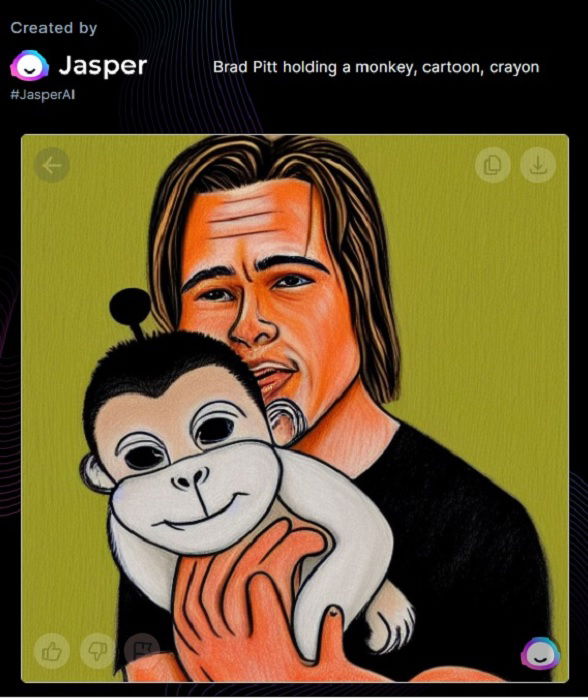
Style and Medium
Free Form mode gives you more prompts for creating images. The next input is Style. You’re given a drop-down list of style options to choose from.
When we originally reviewed this AI software in 2022, the style drop-down gave you 13 options. But now you only have six styles to choose from.
The six remaining styles are Abstract, Anime, Art Deco, Digital, Pop Art, and Surrealism. Other styles like 3D Render and Retro have been removed, which is disappointing.
Another user input option in Jasper Art is Medium. And since 2022, the total number of media to choose from has decreased from 15 to seven.
You can choose from Acrylic, Collage, Ink, Mixed Media, Oil Paint, Photography, and Watercolor. You no longer have Charcoal, Crayon, Classic Oil, or pencil sketch.
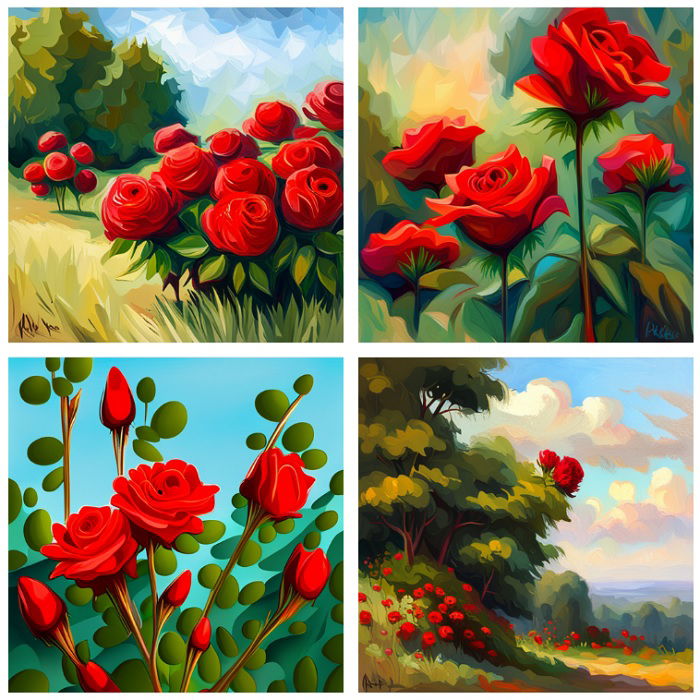
Prompt: Red rose bush, Medium: Oil Paint, Style: Art Deco
Inspiration
Inspiration is your next set of options in Jasper Art. You can choose the style of six famous artists, and the AI bot will generate images in that artist’s style.
Originally, you had eight artists to choose from. But you only have six in the current program. They are Andy Warhol, Claude Monet, Norman Rockwell, Pablo Picasso, Salvador Dali, and Vincent Van Gogh.
The two removed Inspirations were South Park and Pixar. Neither are specific artists, which might be why they were removed.
We have two images generated by Jasper Art below. They are both portraits of Princess Diana with the medium set to acrylics.
The Jasper Art image on the left has been generated with the Inspiration set to Picasso. The right image has Dali as an influence. They’re both distinct and have traits of the named artists.
Image generation like this is fascinating. But I’m not sure either artist would put their name on these pictures.
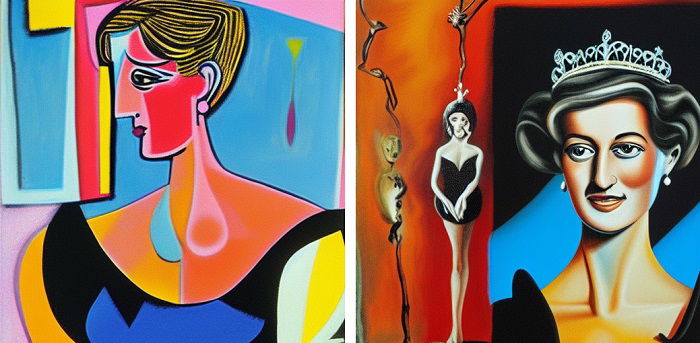
Princess Diana in the style of Picasso (left) and Dali (right)
Mood and Keywords
This AI art generator lets you select a mood for the images. But again, the number of moods on the list has been reduced.
When we last tested the program, you had a list of 19 moods. Now you only have a selection of six moods. That’s a drastic drop-off!
The moods you’re left with are Calm, Exciting, Fun, Gloomy, Happy, and Whimsical. Moods like Aggressive, Energetic, and Dull are no longer there.
The other drop-down list lets you choose keywords. Jasper AI gives you 12 keywords to help you get the image you need. And this has increased from the nine available keywords in our first review.
Keywords are 8K Resolution, Ambien Light, Black & White, Close-Up, Flat Lighting, Full-Face Portrait, Global Illumination, High Resolution, Highly Detailed, Masterpiece, Photorealistic, and Realistic.
Combining an “Ink” medium with the keyword “Realistic” gives you an impressive AI image. Our ink portrait of George Foreman generated by Jasper Art is below.
The likeness isn’t perfect. And it still looks like a digital image. But the effect is impressive.
It has also created some unusual objects on either side of his face. They are perhaps meant to be boxing gloves. But adding strange touches like this is something Jasper Art is prone to do.
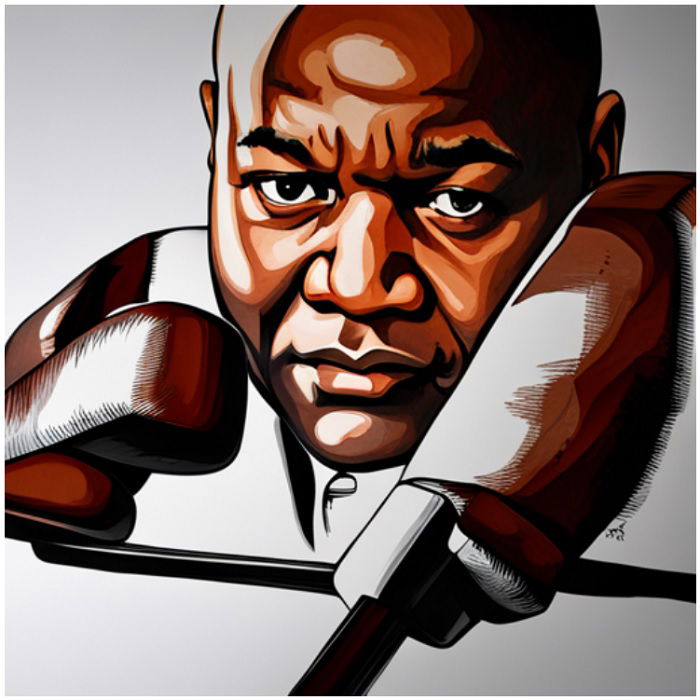
A George Foreman portrait in the Ink medium
Free Form Mode Tips
The AI image generator gives five input options besides the main image description. But you don’t have to fill every box. You can leave some as “none.”
We found less is more when using prompts in Free Form Mode. So we encourage making a few selections and leaving a few as “none.”
The more information you give Jasper Art, the less you get back from the AI tool. If you fill every box, the results are more confusing and less distinct. There’s too much information, and the AI image generation tool can’t handle it.
We gave Jasper Art something simple with a “rat on a boat” description. But we overloaded the program with style, medium, and mood.
The results (below) look good. But Jasper hasn’t exactly followed all the instructions. So it’s best to keep it simple.
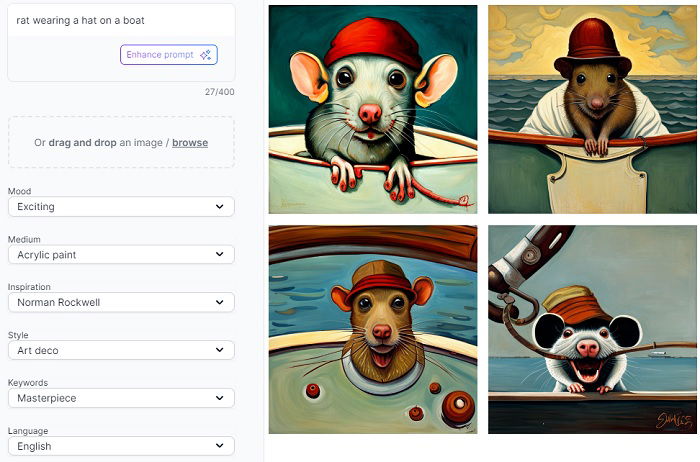
Using the Prompt Box
The prompt is often the key to getting exactly what you want from Jasper. As many users say about AI programs, the results are only as good as your prompt.
As we said, Jasper Art’s prompt box has a limit of 400 characters. You can’t write an essay there. But you can give the bot detailed instructions. But, of course, you need to be concise and specific.
It’s best if you start with a specific subject. It can be an object, animal, famous person, or character.
You’re then free to type other words that indicate the style of picture your want. You can type artists that aren’t featured in the Inspiration.
You can test Jasper’s art knowledge by referencing Joaquin Sorolla or David Hockney. We look at this in more detail below.
We started with something simple. Our input was “sad dog, acrylic, energetic.” You can see the AI-generated art below. We have four nice results, although I’m unsure how “sad” option four is.
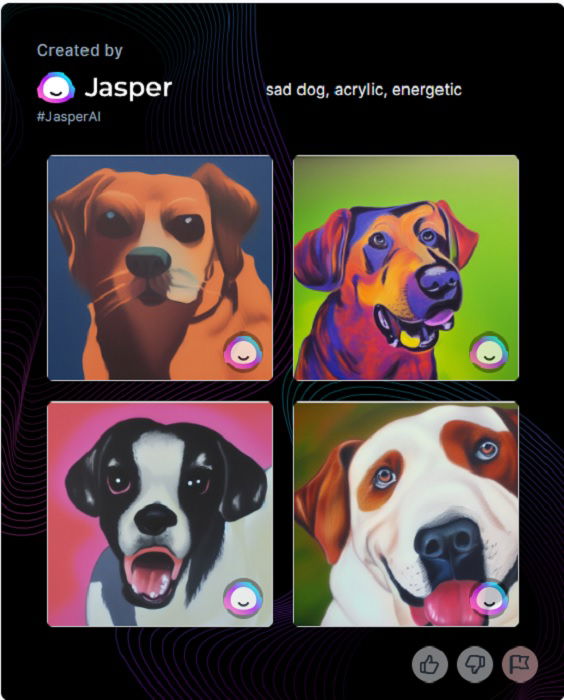
Template Mode
In Template mode, Jasper Art gives you a list of 10 templates to choose from.
The templates are Food Photography, Ink Art, News Graphics, Product Close-Ups, Realistic Animals, Realistic Person, Stock Photography, Storybook Illustration, Travel Photography, and Wallpaper.
You’re given a prompt box when you select the template you want to use. It’s the same prompt box from Free Form Mode with a 400-character limit.
Only here, you don’t have the drop-down options. All your input has to come from the text box.
Template mode is simple to use. But we found it unreliable.
On many occasions, the AI bot wouldn’t generate any images. It would give us an error message to say it hit a snag. We never had this trouble in Free Form mode.
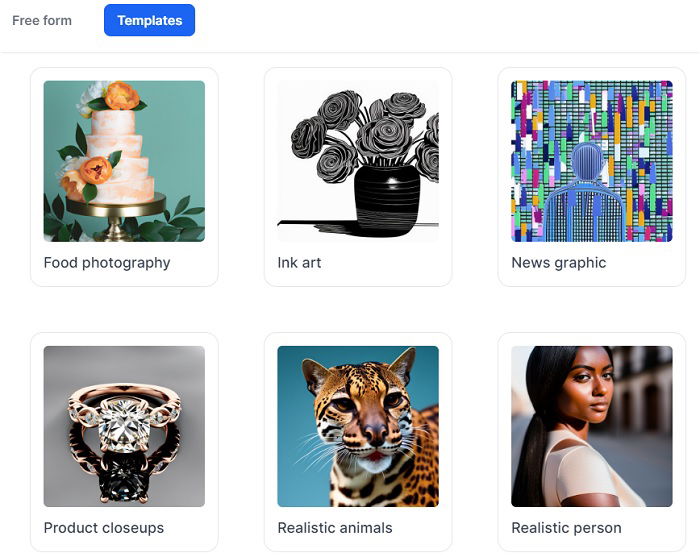
Successes and Shortcomings of Jasper Art
When you first use Jasper Art, there’s no denying it’s impressive. With just a few words and prompts, it turns text into images. And when you stick to the basic inputs, the results are very good.
But Jasper Art doesn’t always hit the mark. We’ve already seen a few examples of strange and inaccurate occurrences. But now we’ll look at Jasper’s shortcomings and limitations in more detail.
Limited Knowledge of Artists’ Styles
As we’ve seen, you can produce images in the style of six artists using the Inspiration drop-down box. First, Jasper has already reduced the inspirations from eight to six.
But we also found limited art knowledge when you use the text box. We put Jasper’s art knowledge to the test by adding artists’ names to the prompt box. And we had mixed success.
Would Jasper Art generate an image in the style of Russian expressionist Wassily Kandinsky? The AI-generated art below does resemble the work of Kandinsky.
The comparison shows Kandinsky’s work on the left and Jasper’s on the right. The style doesn’t match exactly. But there are definite similarities.
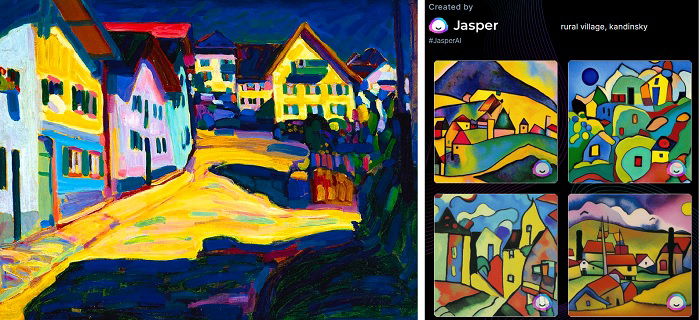
Kandinsky (left) vs Jasper Art (right)
Jasper Art may have missed a few robot art classes, though. We gave it “dog in park, Goya, sad.” The AI image generator gave us four pictures. But they don’t resemble the work of Francisco Goya.
And when we entered “child on the beach, Sorolla,” Jasper couldn’t produce anything. So Jasper Art isn’t an artist imitation app.
Plus, most Jasper Art users don’t want to generate images that look like the work of Goya or Sorolla. People want an AI image generator to produce picture content on any topic. But does it deliver?
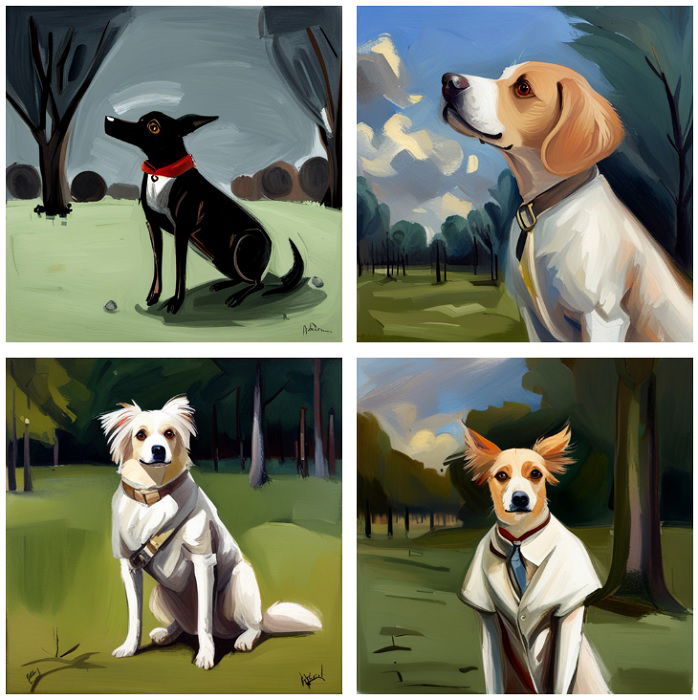
Prompt: Dog in the park in the style of Francisco Goya
Photorealistic Images
Illustrations and artist-inspired works are what some content creators are looking for. But most media producers are looking for high-quality, true-to-life, photorealistic images. Is Jasper Art up to the task?
We have to say Jasper Art’s attempts at photorealism are hit-and-miss. We’ve often been taken aback by the results at first glance. But even after a quick investigation, excitement is replaced by concern.
Objects and Scenes
The best photorealistic results are requests for inanimate objects or lifeless scenes. The fruit bowl below is a good example. We typed “fruit bowl in a country kitchen” with the keyword “photorealistic.”
You know exactly what you’re looking at. And you’d be forgiven for thinking it was a genuine photo—at least at first glance.
Jasper Art’s soft focus effect is the first indication that it’s an AI-generated image. A shallow depth of field is a common tool in photography.
But even in the focused areas, there’s a soft, dreamy texture. Even so, this image wouldn’t look out of place on a food blog.
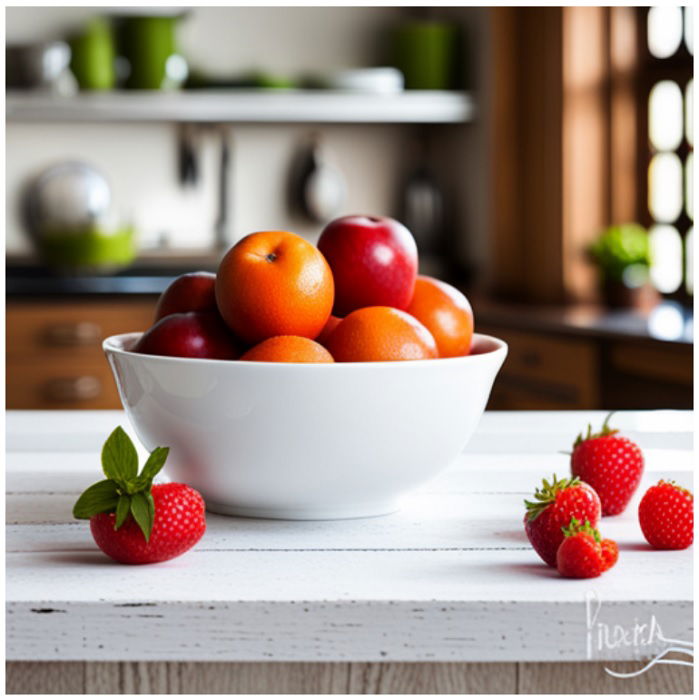
Prompt: Fruit bowl in a country kitchen, Keyword: Photorealistic
Animals
When it comes to realistic animals, Jasper Art also does a decent job. At least it does a decent job sometimes.
With the prompt “cat next to a window,” the medium set to “Photography,” and the keyword set to “Photorealistic,” we generated the image below.
It’s not half bad. The cat looks like a cat. And you even get good texture and detail on the fur.
The polished wooden floor looks excellent too. You could post this on social media, and many would not realize it wasn’t a real photo.
But as with the fruit bowl, we have the image’s soft-focus finish. Everything is slightly fuzzy and soft. And that’s a real tell that this is an AI-generated image.
The other tell is the cat’s left eye. This isn’t well rendered at all. And the eyes, as we’ll see in the next section, are a problem with Jasper Art images.
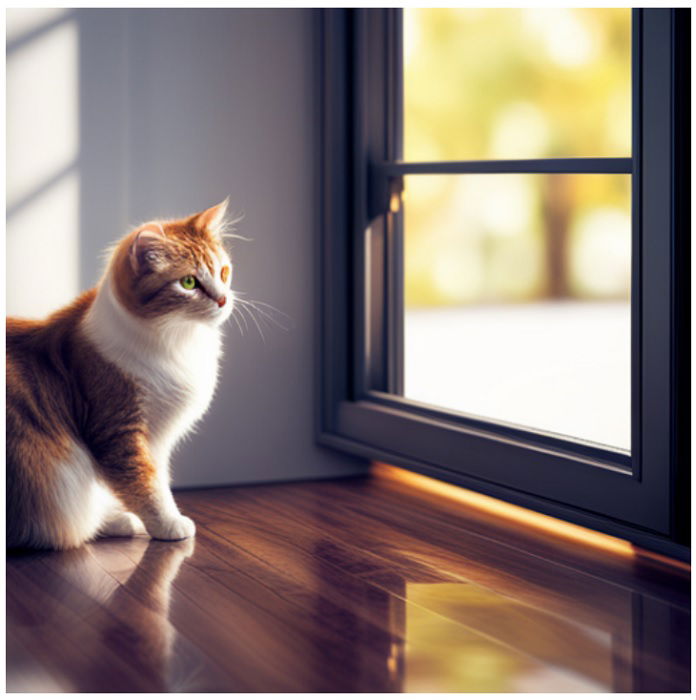
Prompt: Cat next to a window
Jasper Art isn’t always so successful in generating true-to-life animals. As you can see with the monkey images below, they all have an undeniable digital AI quality.
The detail is incredible. But each image looks thoroughly artificial. And that’s even after we used the “photorealistic” keyword from the drop-down box.
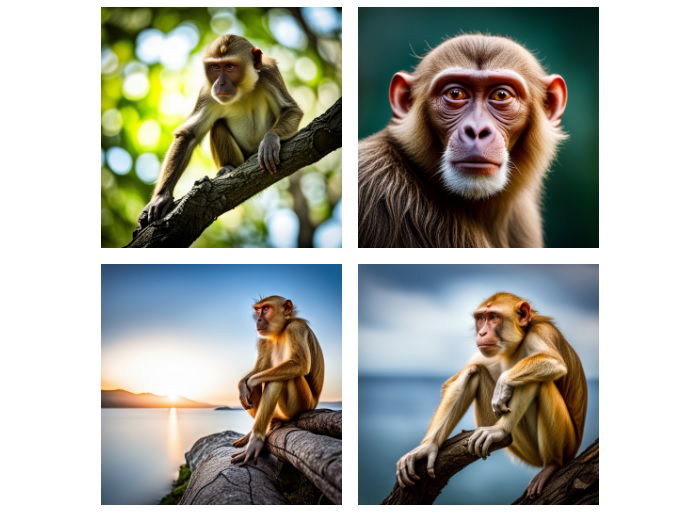
Prompt: Monkey portrait, Mood: Calm, Keyword: Photorealistic
Generic People and Celebrity Faces
When generating photorealistic images of people, Jasper Art is oh-so-close yet oh-so-far. When you generate four images of realistic people, the initial reaction is amazement.
But the more you look at them, the more it just doesn’t look right. Take a brief look at the four images of the Sikh men below.
The fact that Jasper Art created this man out of nothing is mind-blowing. And even the soft focus effect we saw on the animal images is less prevalent.
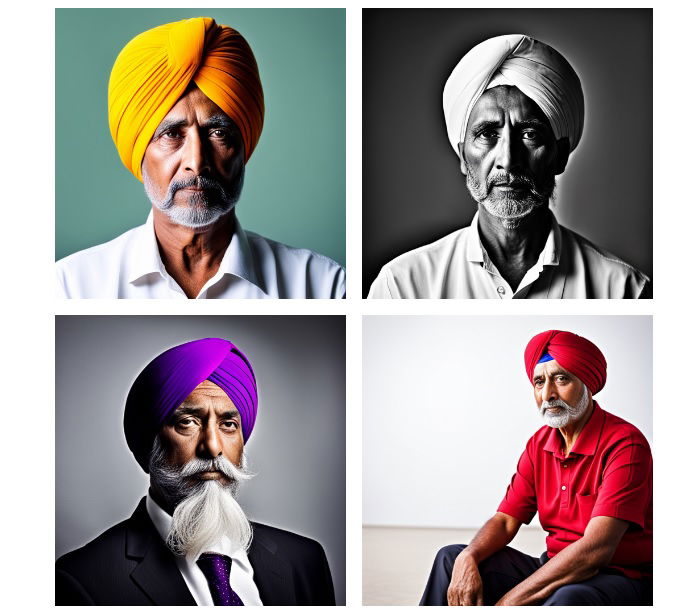
Prompt: Portrait of a Sikh man in a turban, Keyword: Photorealistic
The problem comes when you look at each image more closely. And that problem is with the eyes. It’s one area where Jasper Art slips up.
The Sikh in the yellow turban is the most obvious example. But it’s a feature in every image. Not only are the pupils facing in different directions. The eyes are also different sizes.
This is only one of the main identifiers that help us pick AI images from real images. So photorealism isn’t quite there when you look at the pictures closely.
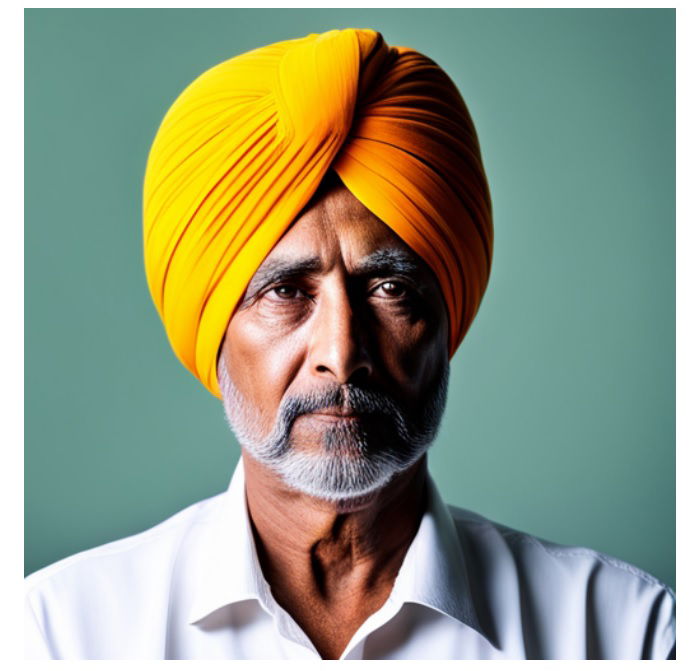
The results are more disappointing when you want photorealistic images of famous faces. Cristiano Ronaldo is one of the world’s most recognizable and photographed people.
That means Jasper has plenty of images to reference. And yet it can’t generate photorealistic images of the football player with any real success.
Again, we see the same problems (pictured below). First, none of the results are particularly photorealistic despite using the “Photography” medium and the “Photorealistic” keyword.
The next problem is that it doesn’t look like Ronaldo. There is a resemblance. But no one is going to believe that’s him. And it has the same problem with the eyes. They are facing different directions.
But Jasper Art‘s failings here are good news for celebrities. Fake images can cause a lot of problems. And using people’s likenesses without their permission might bring up legal issues too.
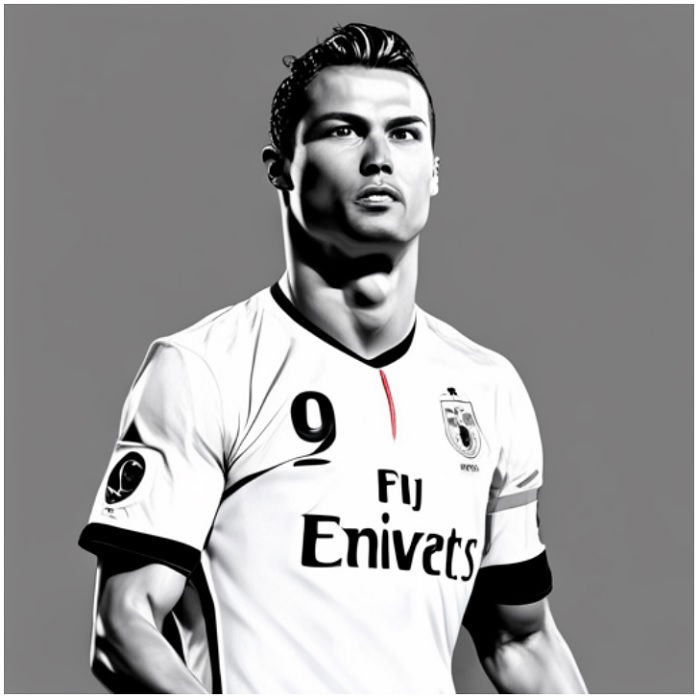
Failing to Answer Prompts
Jasper Art lacks extensive knowledge of artists and their styles. So you can’t set up an AI art forgery business yet. But we’ve also found it can’t always generate images that fit your description.
We entered “frog driving a car” into the prompt box in our original review in 2022. And Jasper Art produced some nice frogs in the “Crayon” medium (pictured below).
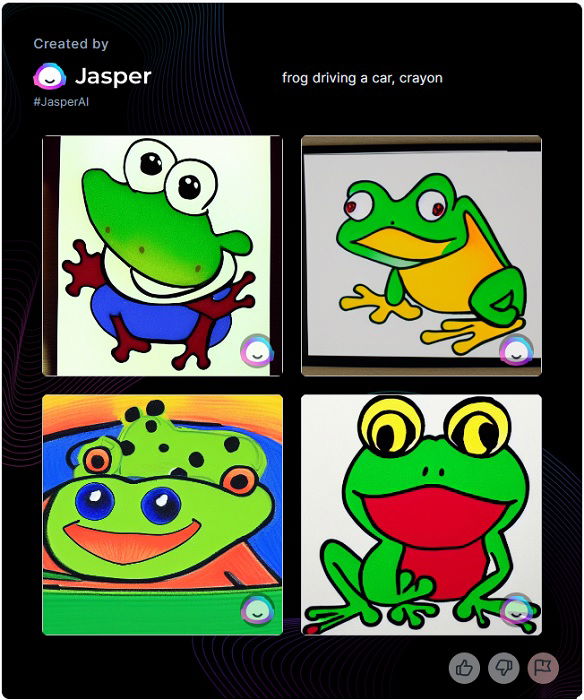
Prompt: Frog driving a car (2022)
But the images generated weren’t exactly what we asked for. Not one of the frogs is sitting behind the wheel of a car.
We tried the same prompt again to see if Jasper Art had improved. We couldn’t use the “Crayon” medium because it’s no longer available. Instead, we used the “Acrylic Paint” medium.
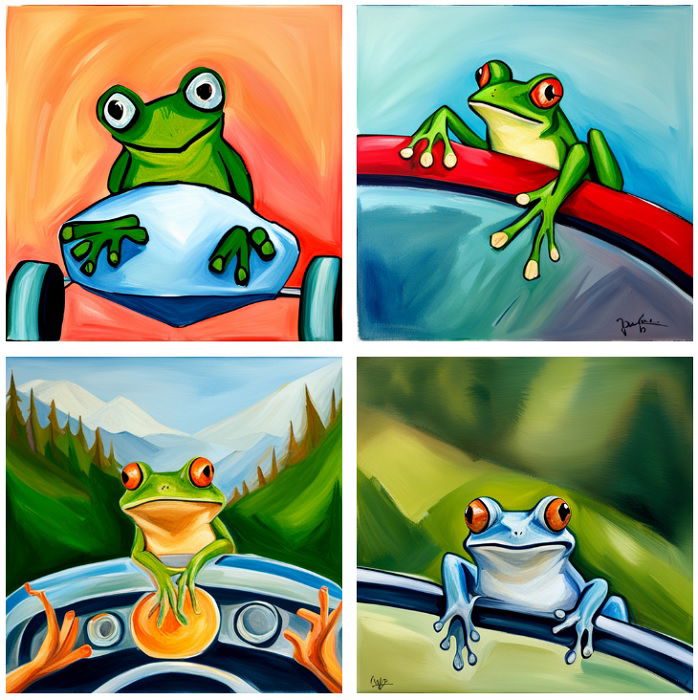
Prompt: Frog driving a car (2023)
The results from our recent test are better. You can see cars or at least car-like features in all the images. But is the frog driving the car in any of them? No, not really.
The fact that Jasper can create these images at all is amazing. But it doesn’t always hit the mark.
A frog driving a car is a silly suggestion. But it illustrates an important point when talking about AI image creation. Jasper Art is intelligent. But it’s still a ways off from creating with human intellect.
You can ask a young child to draw a picture of a frog driving a car. Their execution level might not be as high or quick. But they will understand the concept of a frog driving a car.
Image Uses and Legal Restrictions
Jasper Art lets you create images. But can you use these images commercially? The simple answer is “yes.”
You can use a Jasper Art image in your blog or on marketing material for your company. You can even use them in advertisements. But using Jasper Art images isn’t all smooth sailing.
Images created with Jasper Art fall under a creative commons license. This means the person generating them doesn’t own the rights. Others can then use them as they please.
Plus, Jasper Art generates images using the information it finds online. It actively copies the style of famous artists.
That means there’s a risk an image can infringe on an artist’s or image’s copyright. And as the creator, the user is held responsible.
You also have to be careful using a person’s likeness for advertising. When you use a photo to advertise a product, everyone in the picture must sign a model release form.
A celebrity might be inclined to sue if they see their face on an ad they didn’t know about. So proceed with caution when you use Jasper Art. They do have a good FAQ section on their website.
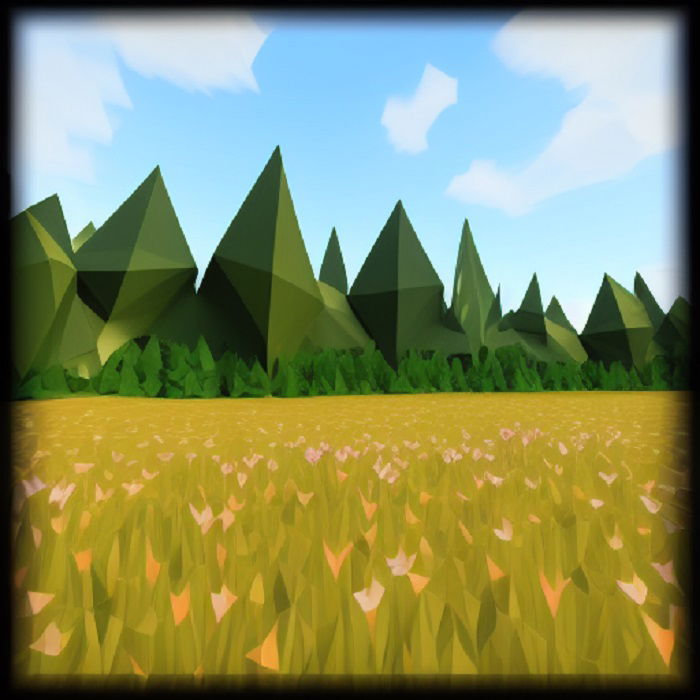
Prompt: Meadow, low poly
Jasper Art Access and Prices
Jasper Art comes as part of Jasper’s subscription packages. You can’t subscribe to Jasper Art on its own. You must choose one of the full plans, including their AI writing tools.
Jasper has three subscription plans to choose from:
- Creator: This is their cheapest plan. It is for individual users and has a limited toolbox.
- Teams: This plan caters to small businesses and collaborative groups. It’s double the price of the Creator plan. But you get more than twice the access.
- Business: This is their top plan. It has no set price, as everything is negotiated to fit your company. Jasper creates bespoke plans to meet your needs as a business.
Jasper Art comes as standard in all the subscription plans. But the problem is that you can’t access it as a stand-alone program. It only exists as an extension to the larger Jasper AI content program.
Jasper Art Alternatives
Jasper Art isn’t the only AI tool in town. There are other AI image generators. The two main rivals are PhotoAI and MidJourney. Both produce custom images from basic text entries.
PhotoAI
If you want photo-realistic images of people, there’s no better software than PhotoAI. It’s an incredible text-to-image AI generation tool that allows you to create original images of yourself or other people in any situation.
PhotoAI has several public “characters” build into the program. But you can also turn yourself into an AI character. All you need to do is feed it photos of yourself, and it creates a character you can use in your AI-generated images. It doesn’t have to be you. You can turn anyone you know into a PhotoAI character.
The software is really easy to use. You don’t need any experience with AI or advanced computer software. The main skill is mastering the prompts. Thankfully, PhotoAI has plenty of pre-programmed prompts you can use with your characters.
You can generate images of your character in different outfits and fashion styles. You can experiment with different scenarios and environments. And you can have the character partake in any activity you can imagine.
PhotoAI isn’t perfect. It still struggles with specific elements, like hands and sports equipment. But overall, the results are truly staggering. The photorealism is outstanding. And many of the images can pass for real photos. It’s the best photo-realistc AI software there is.
Read our full PhotoAI Review to find our more about this incredible software.
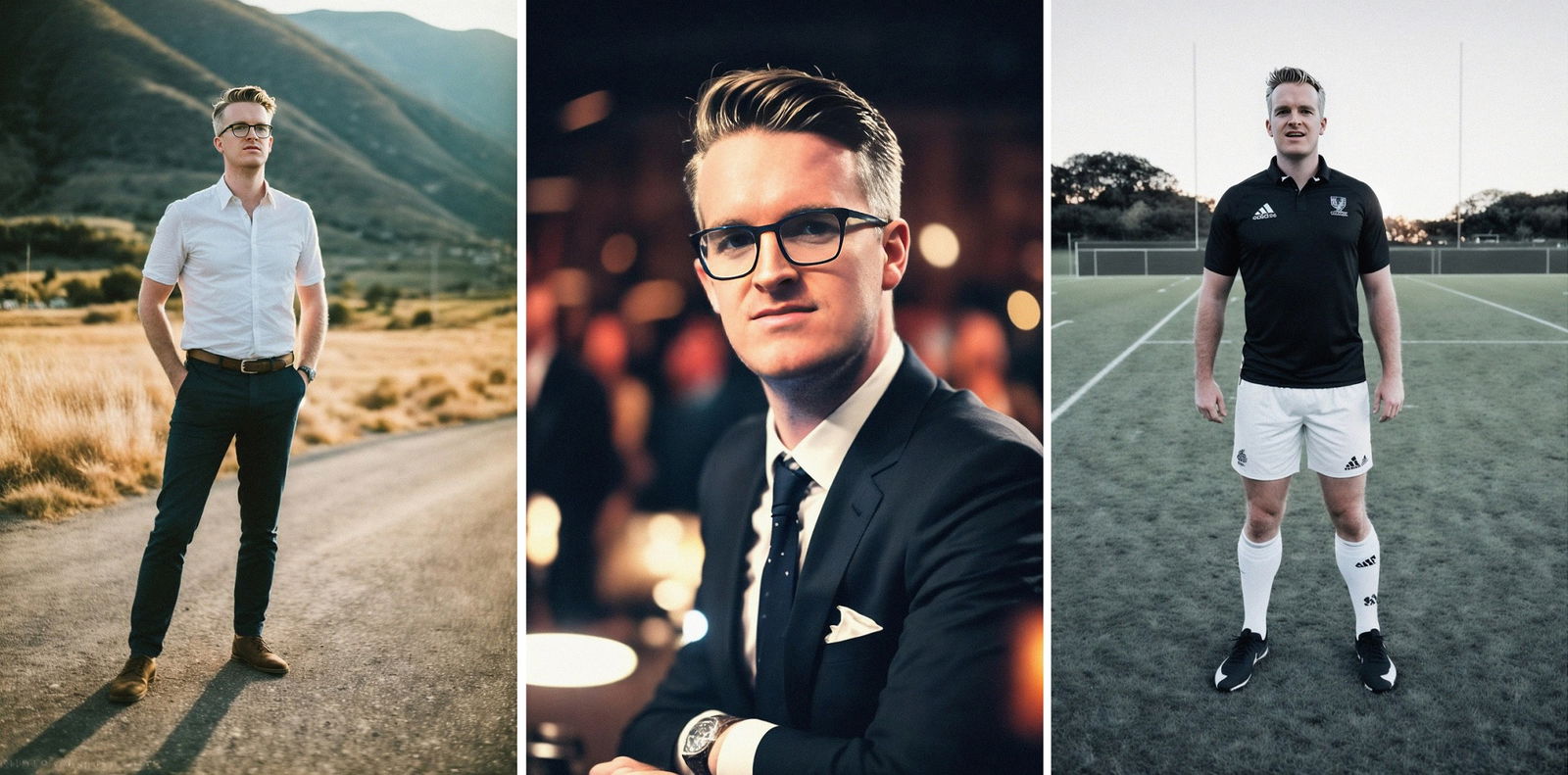
Images of Expert Photography CEO Josh generated on PhotoAI
MidJourney AI
Our colleagues Jenn and Nick have done an in-depth review of Midjourney. They were both very impressed with the results.
Their tests show that the Midjourney AI can handle more input information. And the AI art is intricate and detailed. You can read her full review of MidJourney for more info.
You can test the beta version of Midjourney for free. You get 25 free image generations then you must pay for the service.
For those who want more, there’s a monthly subscription. The basic subscription package gives you 200 image creations a month. And there’s another package with unlimited image generation.
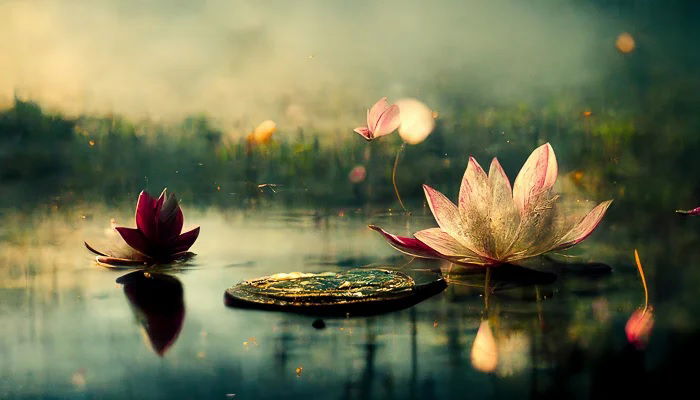
Image Created by Jenn Mishra on Midjourney
Our Verdict for Jasper AI
Writing this Jasper Art review has shown us two things. The first is that AI image generators are amazing tools. Artificial intelligence can transform basic text into stunning images. It can also mimic well-known artists and draw famous faces.
The second thing we’ve learned is that robots aren’t taking over just yet. They’ve taken a few classes at art school. But Jasper Art hasn’t got his full diploma yet.
Photorealistic AI images have come a long way. And the results are genuinely impressive. But they are still far from perfect. Even with the best results, a tell or two identifies it as an AI image.
Jasper Art isn’t an all-in-one creative team. It can mimic many styles. But viewers can often identify AI pictures from those of a talented human. Companies that want real works of art need to employ human artists. Bots create content. Artists create art.
This is a good AI image generator for people needing a lot of fast content. It produces fantastic art images for blogs, marketing emails, and even ads. You can create whole websites with images generated by Jasper Art. And it’s a more creative alternative to using stock photos.
Jasper Art still has its limitations. And these will cause some frustration when trying to create original content. But overall, we think it works well for mid-level content. So try Jasper Art for yourself!
[scores price="no" product="30669″ tag="expertphotog-20″ toc="no" left_title="Measurement" right_title="Score"]

